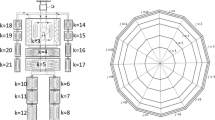Abstract
Three studies are reported that, in general, fail to replicate an earlier investigation by this laboratory (Suter & Loughry-Machado, 1981) in which impressive self-regulation of skin temperature by children was obtained. Mediation of skin temperature biofeedback effects is discussed. It is concluded that biofeedback self-regulation cannot be understood independently of the interpersonal, attitudinal, and cognitive context in which it occurs.
Similar content being viewed by others
References
Alexander, A. B., & Smith, D. D. (1979). Clinical applications of EMG biofeedback. In R. J. Gatchel & K. D. Price (Eds.),Clinical applications of biofeedback: Appraisal and status New York: Pergamon Press.
Blizard, D. A., Cowings, P., & Miller, N. E. (1975). Visceral responses to opposite types of autogenic-training imagery.Biological Psychology, 3 49–55.
Bloch, A. (1980).Murphy's law book two: More reasons why things go wrong! Los Angeles: Price/Stern/Sloan.
Bregman, N. J., & McAllister, H. A. (1982). Motivation and skin temperature biofeedback: Yerkes-Dodson revisited.Psychophysiology, 19 282–285.
Brener, J. (1977). Sensory and perceptual determinants of voluntary visceral control. In G. E. Schwartz & J. Beatty (Eds.),Biofeedback: Theory and research New York: Academic Press.
Guglielmi, R. S., Roberts, A. H., Tellegen, A., & Zimmerman, R. L. (1981). Vasomotor lability and voluntary control of peripheral skin temperature.Psychophysiology, 18 178. (Abstract)
Hama, H., Kawamura, Y., Mine, H., & Matsuyama, Y. (1981). Efficiency of several kinds of feedback in self-control of skin temperature.Psychologia, 24 9–13.
Heistad, D. D., & Abboud, F. M. (1974). Factors that influence blood flow in skeletal muscle and skin.Anesthesiology, 41 139–156.
Herzfeld, G. M., & Taub, E. (1980). Effect of slide projections and tape-recorded suggestions on thermal biofeedback training.Biofeedback and Self-Regulation, 5 393–405.
Hunter, S. H., Russell, H. I., Russell, E. D., & Zimmerman, R. I. (1976). Control of fingertip temperature increases via biofeedback in learning-disabled and normal children.Perceptual and Motor Skills, 43 743–755.
Keefe, F. J. (1978). Biofeedback vs. instructional control of skin temperature.Journal of Behavioral Medicine, 1 383–390.
Kimmel, H. D. (1974). Instrumental conditioning of autonomically mediated responses in human beings.American Psychologist, 29 325–335.
King, N. J., & Montgomery, R. B. (1980). Biofeedback-induced control of human peripheral temperature: A critical review of the literature.Psychological Bulletin, 88 738–752.
Lynch, W. C., Hama, H., Kohn, S., & Miller, N. E. (1976). Instrumental control of peripheral vasomotor responses in children.Psychophysiology, 13 219–221.
Lynch, W. C., & Schuri, U. (1978). Acquired control of peripheral vascular responses. In G. E. Schwartz & D. Shapiro (Eds.),Consciousness and self-regulation: Advances in research and theory (Vol. 2). New York: Plenum.
Lynch, W. C., Schuri, U., & D'Anna, J. (1976). Effects of isometric muscle tension on vasomotor activity and heart rate.Psychophysiology, 13 222–230.
Maslach, C., Marshall, G., & Zimbardo, P. G. (1972). Hypnotic control of peripheral skin temperature: A case report.Psychophysiology, 9 600–605.
Mittleman, B., & Wolff, H. G. (1939). Affective states and skin temperature: Experimental study of subjects with “cold hands” and Raynaud's syndrome.Psychosomatic Medicine, 1 271–292.
Nowicki, S., & Duke, M. P. (1974). A preschool and primary internal-external control scale.Developmental Psychology, 10 874–880.
Peters, J. E., Lundy, R. M., & Stern, R. M. (1973). Peripheral skin temperature responses to hot and cold suggestions.International Journal of Clinical and Experimental Hypnosis, 21 205–212.
Segreto-Bures, J., & Kotses, H. (1982). Experimenter expectancy effects in frontal EMG conditioning.Psychophysiology, 19 467–471.
Suter, S. (1977). Independent biofeedback self-regulation of EEG alpha and skin resistance.Biofeedback and Self-Regulation, 2 255–258.
Suter, S., & Loughry-Machado, G. (1981). Skin temperature biofeedback in children and adults.Journal of Experimental Child Psychology, 32 77–87.
Suter, S., Schweikart, C., & Jordan, T. (1978).Kids can do it! Unpublished manuscript. (Available from Steve Suter, California State College, Bakersfield, California 93309).
Taub, E. (1977). Self-regulation of human tissue temperature. In G. E. Schwartz & J. Beatty (Eds.),Biofeedback: Theory and research. New York: Academic Press.
Taub, E., & Emurian, C. S. (1976). Feedback aided self-regulation of skin temperature with a single feedback locus. I. Acquisition and reversal training.Biofeedback and Self-Regulation, 1 147–168.
Taub, E., & School, P. J. (1978). Some methodological considerations in thermal biofeedback training.Behavior Research Methods and Instrumentation, 10 617–622.
Zimet, G. D. (1979). Locus of control and biofeedback: A review of the literature.Perceptual & Motor Skills, 49 871–877.
Author information
Authors and Affiliations
Additional information
A brief report of Experiment 1 was presented by the second author at the meeting of the Western Psychological Association, Los Angeles, April 1981. This research was supported in part by Grant SPI79-26853 from the National Science Foundation to David C. Cohen and Grant SPI80-24946 to the first author. John Herndon assisted capably in the planning, conduct, and analysis of Experiment II.
Rights and permissions
About this article
Cite this article
Suter, S., Fredericson, M. & Portuesi, L. Mediation of skin temperature biofeedback effects in children. Biofeedback and Self-Regulation 8, 567–584 (1983). https://doi.org/10.1007/BF00998764
Issue Date:
DOI: https://doi.org/10.1007/BF00998764




